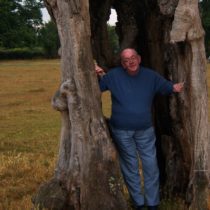Landscape Architecture for Landscape Architects › Forums › GENERAL DISCUSSION › Community Tree Plantings
- This topic has 1 reply, 7 voices, and was last updated 13 years, 3 months ago by
 landplanner.
landplanner.
-
AuthorPosts
-
August 16, 2012 at 10:44 pm #156716
 PGA DesignParticipant
PGA DesignParticipantMy firm is preparing a reforestation plan for West Oakland, California. They have asked us to tell them how many additional trees should be planted and to suggest how long it should take to it done. They want to know how many trees other grassroots groups have been able to plant in other communities.
I would appreciate hearing from anyone who has some experience with this.
August 17, 2012 at 12:12 am #156734 landplannerParticipant
landplannerParticipantHello PGA:
This non-profit has been doing tree planting on a house-by-house, street-by-street, neighborhood-to-neighborhood in Portland, Oregon for a very long time.
If they can’t answer your questions, have them refer you to the Urban Forester for the City of Portland. (Portland Parks Bureau). They take urban forestry very seriously in Portland and practice the same way.. Same goes for Seattle.
August 17, 2012 at 11:13 pm #156733 Tyson CarrollParticipant
Tyson CarrollParticipantThe answer to that question depends on several factors
– Are the officials asking how many trees are going to be planted by volunteers for the entire plan or in one sitting?
– What is the organizational capacity of the city and other organizations that would assist with this effort?
– Does the city have established volunteer days throughout the year? ie make a difference day, earth day, or arbor day
– What type of reforestation projects are you referring to- parks? street trees?
– What size of trees are you specing?
– Soil conditions?
I work at a non-profit and we organize alot of volunteer plantings for cities and municipalities. What I can tell you is that we average between 50-200 volunteers at each event 3 times throughout the year. Volunteers typically have 2-4 good hours in them but alot depends on the children. On average we plant 400 trees (5 gal and 15 gal) and 2000 shrubs (1 gal) a year.
August 18, 2012 at 11:11 pm #156732 Les BallardParticipant
Les BallardParticipantI am sorry but have to ask, without really expecting a reply, why your firm has been asked to do this apparently with no adequate brief.
I have read the other replies and can only add these points:
It could be good to plan 4 phases – street trees, others say in parks, both using paving and other aspects that may take some time, money and effort by professionals, using appropriate species,
basic planting to include large and small trees involving schoolchildren over a number of days at say 4 hours a day with free soup, prizes, etc. Children can grow some trees from seed and even provide tree spirals, tubes, stakes and string, etc.
extra planting to fulfill various desires and use private land like front gardens where owners will take responsibility for watering, etc. and the public can see but not go. One example would be a mini or sub arboretum of all the trees in the various holy books. Locals may again provide seed and even healthy trees as a part of their cultural or religious social activities. Will the local authority tend them all though?
Authorities may have a map showing all trees, that will need updating, using a diary programme and schedule for upkeep and a sub-committee put together to agree siting so that nothing is planted without permission that may interfere with homes, sewers, utilities, etc. Thirteen agencies here may get permission to dig any road each employing any number of contractors and in receiving permission will have to be told whether to remove, work round, move or otherwise cope with any planting. Some planting can be allowed in sensitive areas if, for example, the trees are in a buried container so that no ingress is made by roots to tunnels, etc. It may or may not be appropriate to plan watering by a system like grey water / leaky hose under gravity from a municipal building nearby/uphill.
It is sad that so far nearly all municipal planting has no native species but are a park variety costing more than wild natives, no fruit – almost – is planted for folk to take or to be used for children’s meals or for the elderly freely. No timber goes to the benefit of schools, etc. so reducing imports but instead goes by contract to parties the authority employs to clean up. Authorities could grow all their own stakes, fencing, board for shuttering, etc. as well as sell firewood / make pressed dust logs but never seem to do so.
Good luck.
August 20, 2012 at 2:27 pm #156731 Tosh KParticipantAugust 21, 2012 at 2:16 pm #156730
Tosh KParticipantAugust 21, 2012 at 2:16 pm #156730 Jordan LockmanParticipant
Jordan LockmanParticipanthttp://www.treetrust.org/ – They are planting trees like crazy around the metro here.
August 21, 2012 at 6:10 pm #156729 PGA DesignParticipant
PGA DesignParticipantThanks for this lead. Friends of Trees looks like a fantastic group – planted 450,000 trees since 1989 – that’s impressive.
August 21, 2012 at 6:14 pm #156728 PGA DesignParticipant
PGA DesignParticipantTyson,
All good questions. The West Oakland Green Initiatives is an all-volunteer group that seeks grants, donations and volunteer labor to plan, plant and maintain street trees in a neighborhood confronted with many challenges. This basic question is intended to find out what others are doing, how they are doing it and what sort of results can reasonably be expected, so your answer is very helpful. Thank you.
August 21, 2012 at 6:23 pm #156727 PGA DesignParticipant
PGA DesignParticipantLes,
I appreciate your distress by my presenting my question without context and can assure you that this is only one question of many we are addressing as part of a comprehensive Reforestation Plan for West Oakland.
My client is a grassroots group that has been planting trees for several years. They have a track record and now what they have been able to accomplish but are interested in learning more about what other non-profits are doing.
I realize I’ve asked a very simple question about a very complex, multi-layered issue. There are many things to consider. One of the drivers for this particular study is relating planting trees to potential environmental benefits.
Thanks for your response.
August 21, 2012 at 6:26 pm #156726 PGA DesignParticipant
PGA DesignParticipantRussell,
Yes, we will be advising our client on a total number of trees that would be desirable to plant to achieve the desired environmental benefits. I believe what my client is after is some idea of how long it will take to achieve an optimal tree canopy.
They do know what they have been able to accomplish in past years but want to know what others are doing and how they are doing it.
Thanks for your response.
August 21, 2012 at 6:38 pm #156725 PGA DesignParticipant
PGA DesignParticipantJordon,
Wow, another very impressive organization doing great work. Thanks for sending the link. These folks look like a tremendous resource.
Chris
August 21, 2012 at 6:46 pm #156724 PGA DesignParticipant
PGA DesignParticipantTosh,
Looking at all these websites is an inspiration. I’m glad I posted this question and am learning about some great organizations doing fantastic work.
Chris
August 22, 2012 at 12:02 am #156723 Andrew Garulay, RLAParticipant
Andrew Garulay, RLAParticipantHave they mapped out an inventory of what now exists?
August 22, 2012 at 1:01 am #156722 Les BallardParticipant
Les BallardParticipantThere are disparate groups but also groups of groups and they advise members on various issues. There are likely groups wherever folk think of “green” protests and so-called tree-huggers. For you that may mean those who try to save the redwoods in Ca. and those working in the Seattle area. Wherever there are permaculture (which google) projects and even good old fashioned communes there is usually a plethora of small press networking and I would particularly direct you to one of these perhaps set up as a co-operative. The reason for this is that there are co-ops of co-ops who seek to help and advise members just as local authorities have their associations and you can learn of this senior group from one member. In many ways we are all hostage not to our local authorities but what their associations tell them to do. Of course many co-ops and other groups have political leanings you or your clients may wish to disassociate themselves from but trying to do good can make for strange bedfellows. So, please, in Ca. especially, talk to those who remain and still get called hippies whether they are, are socialists, communistic, modern anarchist or whatever. There are many tie-ins between such groups and acknowledged experts in universities there and elsewhere who are interested in the ecological activities not politics or lifestyles. Personally, being Pagan, I would tour the occult and new age shops there n the first instance collecting contact details from leaflets and seeing who is into what with whom. You will also find religious folk of all kind happy to help with labour and expertise as part of their outreach into the community and popularisation of their religion from Jains, Sikhs and Hindus to Muslims and Jews. Finally, in more standard and richer economical areas and communities, there are all kinds of gardening and flower groups and cross-overs with other organisations including academics. For example, the mayor could be into fuschias and the local tree expert into orchids. There are also land sharing groups and even barter or fruit gleaning and sharing groups in many areas where there are few gardens for those who want them or older folk who may be happy to have their grounds used by younger folk. These upwardly mobile young people, perhaps anxious to grow a few vegetables for their families, may have the inclination and verve to help you and cetainly as parents via schools and the parent groups associated wit them.
August 22, 2012 at 5:40 am #156721 landplannerParticipant
landplannerParticipantChris:
Here is an article that is a must read for what your attempting to do for this community group and how those efforts and the overall tree canopy for the city those trees grow in, can be inventoried and updated.
This is recent and from San Diego. The same kind of project has been done in San Francisco, so you may already be aware of it.
http://www.utsandiego.com/news/2012/mar/22/taking-inventory-of-the-countys-trees/?print&page=all
Here is the link to the California Energy Center’s Urban Forestry webpage dedicated to the San Diego County Tree Map. This is huge…..
http://energycenter.org/index.php/urbanforestry
Finally, have you reached out and contacted this group yet ?
Bay Area Urban Forest Ecosystem Council
Christian Bonner – cbonner@wcainc.org
Ray Morneau – ray@rmarborist.comWow, I do incredible and no-charge research, on-the-fly, really well…..
-
AuthorPosts
- You must be logged in to reply to this topic.


